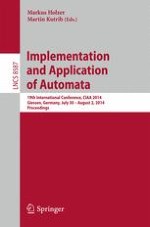This book constitutes the refereed proceedings of the 19th
International Conference on Implementation and Application of Automata, CIAA 2014, held in Giessen, Germany, in July/August 2014.
The 21 revised full papers presented together with 4 invited papers were carefully selected from 36 submissions. The papers cover all aspects of implementation, application, and theory of automata and related structures such as algorithms on automata, automata and logic, bioinformatics, complexity of automata operations, compilers,
computer-aided verification, concurrency, data structure design for
automata, data and image compression, design and architecture of
automata software, digital libraries, DNA/molecular/membrane computing, document engineering, editors, environments, experimental studies and practical experience, implementation of verification methods and model checking, industrial applications, natural language and speech processing, networking, new algorithms for manipulating automata, object-oriented modeling, pattern-matching, pushdown automata and context-free grammars, quantum computing, structured and semi-structured documents, symbolic manipulation environments for automata, transducers and multi-tape automata, techniques for graphical display of automata, VLSI, viruses and related phenomena, and world-wide Web.
